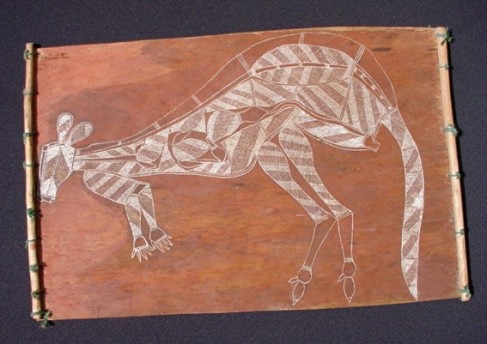The act of viewing and comparing the art of Oceania quickly reveals the diversity of cultural societies that developed distinctly from one another in this part of the world. You can also see the influence of environment when comparing art objects from two different regions that make up Oceania: Aboriginal Australia and island Melanesia and Polynesia.
In the first example, a modern bark painting from Australia (image credit), reflects the Oenpelli tradition of x-ray rock painting, as well as bark-painting. While the outline of the kangaroo figure is curvilinear, the majority of line and decoration is straight, with cross-hatching patterns.
Contrasting with that, is the more curved, circular, and flowing lines seen in the island regions, Melanesia and Polynesia. There is a general influence of ocean in this region’s decoration and objects, including in the Maori war canoe bow-piece (image credit). There are very few straight lines, and the overall impression is one of flowing, soft curves.
The sense of straightness and angles of the bark painting contrasts with the curvilinear, circular design of the canoe piece. One could easily relate the bark painting’s use of straight lines to the environmental influence of grass, and this type of straight patterning is seen in other Aboriginal Australia art as a common motif and style, including Yirrkala wooden figures, shell necklaces, and other 2-dimensional depictions. The scroll-like, curvilinear design of the canoe, on the other hand, is reminiscent of water and waves, and those curves are seen in the style of island art, throughout the diverse cultures. There is an distinctness to these examples and their use of straight or curving lines, that while somewhat opposing, makes them appealing as a pair, as well as illustrative to the diversity of Oceanic art.


Recent Comments